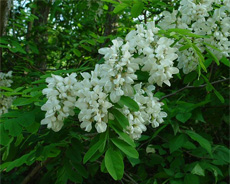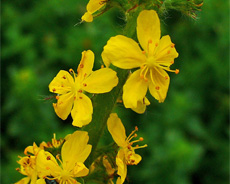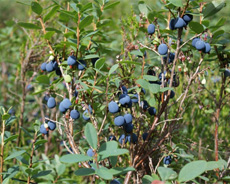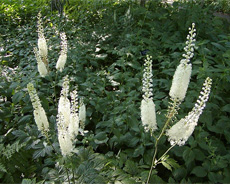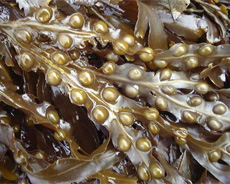
Medicinal
Plants contain phytochemicals that have effects on the body. Some types of herbal extract, such as the extract of St. John's-wort or of Kava can be used for medical purposes to relieve depression and stress. One herb, called Shilajit, may actually help lower blood glucose levels which is especially important for those suffering from diabetes. Herbs have long been used as the basis of traditional Chinese herbal medicine, with usage dating as far back as the first century CE and far before.
Medicinal use of herbs in Western cultures has its roots in the Hippocratic (Greek) elemental healing system, based on a 4-fold elements healing metaphor. Famous herbalist of the Western tradition include Avicenna (Persian), Galen (Roman), Paracelsus (German Swiss), Culpepper (English) and the botanically inclined Eclectic physicians of 19th century/early 20th century America (John Milton Scudder, Harvey Wickes Felter, John Uri Lloyd). Modern pharmaceuticals had their origins in crude herbal medicines, and to this day, many drugs are still extracted as fractionate/isolate compounds from raw herbs and then purified to meet pharmaceutical standards.
Acacia
Herbalists use acacia gum to bind pills and lozenges and to stabilize emulsions. It is also used in aromatherapy for applying essential oils. Gum arabic is used widely as an ingredient in foods like candies and soft drinks, the gum has the properties of a glue that is safe to eat. Acacia gum is widely used in organic products as natural alternative to chemical binders.
Acacia has Small flowers which have five very small petals, almost hidden by the long stamens, and are arranged in dense globular or cylindrical clusters; they are yellow or cream-colored in most species, whitish in some, even purple (Acacia purpureapetala) or red (Acacia leprosa).Class:Shrub Leaves:Pinnate, feather-like, the plants often bear spines, especially those species growing in arid regions. Preferred Habitat:Tropical Flowering Season:Spring Distribution:Sub-Saharan Africa, most abundant in the Dafur region of Sudan
The acacia is a plant in the subfamily Mimosacaea(sometimes considered a family, Mimosaceae ) , of the flowering plant family Fabaceae(the legumes), of mostly tropical and subtropical trees and shrubs. The trees produce the most resin under stress conditions.
Agrimony
Agrimony tea is safe for small children
Agrimony's astringency is effective against diarrhea, especially in small children, and because of its low toxicity, the herb is particularly suitable for children's illnesses. Agrimony stops irritation of the urinary tract that may increase a child's urge to urinate and, therefore, may be useful in the treatment of bladder leakage (cannot hold urine), bed-wetting and adult incontinence.
Agrimony is perhaps best known as a wound herb used on medieval battlefields to staunch bleeding. Agrimony is most used in modern herbal practice as a mild astringent and a tonic, the tannins it contains tone the mucus membranes making it is useful for alleviating the symptoms of coughs, bronchitis and asthma. The herbal tea can be used as a skin wash, it is thought to improve minor injuries and chronic skin conditions.
Flowers: terminal spikes of small yellow flowers. Stem: 3 to 4 feet Leaves: Paired leaves, green above and silvery beneath Preferred Habitat: Full sun, average soils and dry weather Distribution: Much of the United States and Southern Canada.
Anise
Anise has been a popular remedy here in North America for hundreds of years as carminative (relief of gas pains),colic, rheumatism, and of course in the famous licorice tasting cough drops.
The therapeutic powers of anise's phytochemicals, including creosol and alpapinene, are commonly used in herbal remedies to break up congestion, and ease coughing . Anise is an expectorant that is also antiseptic to the mucous membranes. This means that anise helps to kill germs while it helps to clear the lungs of congestion.
Another important chemical constituent of anise is anethol, which has estrogenic properties that help to increase milk in nursing mothers, promote menstruation, and help prepare the body for childbirth. These hormonal actions may be the reason behind anise's ancient reputation as an aphrodisiac.
Flowers:Small white and yellow flowers produced in umbrels Stem: Tall stalks, 1 to 2 feet hight Leaves: Feather like ovate, divided, bright green Seeds: The essential oil is distilled from the seeds. Preferred Habitat: Hot summers needed for seeds to ripen Flowering Season:Summer Distribution: Eurasia and N. Africa.
Billberry
Billberry is best known for it's beneficial effects on eyesight Bilberry is one of the most trusted herbal medicines for eye health. Bilberry fruits contain chemicals called anthocyanosides that support good circulation in the small capillaries around the eyes.
Bilberry has beneficial effects on many disorders, from poor vision, and diabetes to high cholesterol and blood pressure. Because capillary damage is the primary factor in a number of eye diseases, such as diabetic retinopathy, glaucoma, and cataracts, bilberry extracts are often promoted as a source of protection. This great tasting berry also finds a place in the home herbalist's medicine cabinet as a simple and effective remedy for reducing bruises from black eyes. Bilberries are powerful antioxidants, and add "purple berry power" to herbal teas.
Plant type: shrub that grows to about one foot Fruit: Sweet, blue berries.. Preferred Habitat: Damp, acidic soils. Distribution: North America and Europe
Black Cohosh
Black cohosh cools hot flashes and other symptoms of menopause. Black cohosh contains numerous chemical constituents, among them isoflavones like formononetin, which mimics hormonal activity. Though it is known primarily as a woman's herb, it is also acts as a nervine, giving relief to headaches, pain and muscle spasms. These pain relieving properties, coupled with it's anti-inflammatory action make the herb useful against the pain of arthritis.
Though black and blue cohosh are unrelated, they are often used together and have a synergistic, not interchangeable, relationship...While blue cohosh is primarily associated with blood flow to the pelvic area, black cohosh maintains it's effects through it's estrogen-like action. Black cohosh has a special affinity with menopausal women and is used in formulas to balance and regulate hormonal production during menopause.
Bladderwrack
Kelp is commonly used in herbal medicine to stimulate the thyroid function, and can be effective in weight loss as part of a low calorie diet. The consumption of seaweeds has also been associated with lower cancer rates.
Kelp, or dried seaweed, Fucus vesiculosis, was the original source of iodine, being discovered as such by Courtois in 1812. Iodine does not occur in nature in the uncombined condition, but is widely, though sparingly, distributed in the form of iodides and iodates, chiefly of sodium and potassium, in seawater, some seaweeds, and various mineral and medicinal springs. Kelp is an important part of the diet in Japan, Norway, and Scotland.
For vegans (vegetarians who eat no animal products at all), it supplies vitamin B12, otherwise found almost exclusively in animal products, and is a concentrated source of minerals, including iodine, potassium, magnesium, calcium, and iron. As a source of iodine, it assists in the production of of thyroid hormones, which are necessary for maintaining healthy metabolism in all cells of the body. The brown algae known as bladderwrack is a particularly common source of kelp.
Calendula
The deep orange and yellow flowers of Calendula hold the medicinal properties that make Calendula one of the most loved flowers in herbal skin care. Calendula petals yield a fixed oil that is beneficial for many types of skin problems, and mild enough to use in almost any situation.
Calendula oils, creams and salves make it a particularly good treatment for cuts, scrapes, bruises, and minor wounds. It is an excellent idea to keep calendula treatments handy for a first aid kit.
Calendual flowers are anti-bacterial and a tea infusion of the fresh petals is useful as an eyewash for conjunctivitis (pink eye). Calendula tinctures and teas can also calm stomach upsets, reducing inflammation and yeast overgrowths that can be root causes of food allergies, gastritis and irritable bowel problems
Flowers: The flowers are the part used in herbal medicine. Calendula bears many-petaled orange or yellow flowering heads two to three inches (four to seven centimeters) in diameter. Plant type: annual or biennial Leaves: The oblong green leaves help to distinquish calendula from tagetes marigolds, an unrelated species Flowering Season: Begins in June. Its name refers to its tendency to bear flowers by the calendar, once a month in warm climates, usually during the new moon.
Chamomile
A cup of chamomile tea is a natural sleep inducer
The seemingly endless list of uses for chamomile can all be traced to its effects on the nervous system and digestive system, as well as its anti-inflammatory and antibacterial properties. Chamomile is a great herb to grow in the garden or buy in bulk, because there are so many different and amazing uses for it.
Chamomile is an mild but effective remedy for delayed menstruation and irregular menstruation, and is especially helpful in these conditions that may be triggered by stress, anxiety, and tension. Chamomile contains spiroether, a very strong antispasmodic agent that relaxes aching, tense muscles and alleviates premenstrual pain.
Chamomile tea and chamomile oil are safe to use for children who have trouble sleeping, or are under stress. The herb is safe enough to use for infants and is a favorite remedy for colic.
Chamomile calms anxiety, eases stress and may have a positive effect on attention deficit disorder (ADD). Laboratory tests on animals show that inhaling the vapors of essential oil of chamomile reduces the body's production of adrenocorti-cotropichormone (ACTH), a stress hormone.
Cranberry


Cranberries are a native plant of North America and are a healthy source of antioxidants and also used in herbal medicine. Historically, cranberry fruits and leaves were used for a variety of problems, such as wounds, urinary disorders, diarrhea, diabetes, stomach ailments, and liver problems. Today most of the medicinal interest in cranberries is in the area on urinary tract health, indeed drinking cranberry juice at the first sign of a UTI, is one of the best known home remedies. Cranberry juice helps flush out the urinary system by keeping bacteria from getting a foothold in the lining of the urinary tract. Cranberry juice has also been used infrequently in conjunction with antibiotics to treat chronic kidney inflammation. Some people concerned about their intake of sugar have turned to dried cranberry capsules, and powders.
Cranberries are a group of evergreen dwarf shrubs or trailing vines found in acidic bogs throughout the cooler parts of the Northern Hemisphere. Cranberries are related to the bilberries, blueberries, and huckleberries, all in Vaccinium subgenus Vaccinium. The flowers are dark pink, with very distinct reflexed petals, leaving the style and stamens fully exposed and pointing forward. They are pollinated by domestic honey bees. The fruit is a berry that is larger than the leaves of the plant; it is initially white, but turns a deep red when fully ripe. It is edible, with an acidic taste that can overwhelm its sweetness.

